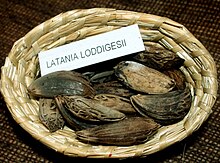Broad-billed parrot
[4] The British naturalist Hugh Edwin Strickland assigned the "Indian ravens" to the hornbill genus Buceros in 1848, because he interpreted the projection on the forehead in the 1601 illustration as a horn.
[2] Even after subfossils of a parrot matching the descriptions were found, the French zoologist Emile Oustalet argued in 1897 that the "Indian raven" was a hornbill whose remains awaited discovery.
[5] The first known physical remain of the broad-billed parrot was a subfossil mandible collected along with the first batch of dodo bones found in the Mare aux Songes swamp.
[6] The British biologist Richard Owen described the mandible in 1866 and identified it as belonging to a large parrot species, to which he gave the binomial name Psittacus mauritianus.
[8] In 1868, shortly after the 1601 journal of the Dutch East India Company ship Gelderland had been rediscovered, the German ornithologist Hermann Schlegel examined an unlabelled pen-and-ink sketch in it.
Realising that the drawing, which is attributed to the Dutch artist Joris Joostensz Laerle, depicted the parrot described by Owen, Schlegel made the connection with the old journal descriptions.
Because its bones and crest are significantly different from those of Psittacus species, the British zoologist Alfred Newton assigned it to its own genus in 1875, which he called Lophopsittacus.
Considering its large jaws and other osteological features, Newton and Gadow thought it to be closely related to the Rodrigues parrot in 1893, but were unable to determine whether they both belonged in the same genus, since a crest was only known from the latter.
[14] Many endemic Mascarene birds, including the dodo, are derived from South Asian ancestors, and the British ecologist Anthony S. Cheke and Hume have proposed that this may be the case for all the parrots there as well.
Hume has suggested that they have a common origin in the radiation of the tribe Psittaculini, basing this theory on morphological features and the fact that parrots from that group have managed to colonise many isolated islands in the Indian Ocean.
[5] The Psittaculini may have invaded the area several times, as many of the species were so specialised that they may have evolved significantly on hotspot islands before the Mascarenes emerged from the sea.
Ridges on the skull indicate that its distinct frontal crest of feathers was firmly attached, and that the bird, unlike cockatoos, could not raise or lower it.
[17] A 1602 account by the Dutch sailor Reyer Cornelisz has traditionally been interpreted as the only contemporary mention of size differences among broad-billed parrots, listing "large and small Indian crows" among the animals of the island.
[3] The last account of the bird, and the only mention of specific colours, was by the German preacher Johann Christian Hoffman in 1673–75: There are also geese, flamingos, three species of pigeon of varied colours, mottled and green perroquets, red crows with recurved beaks and with blue heads, which fly with difficulty and have received from the Dutch the name of Indian crow.
[21] The head was evidently blue, and in 2007, Hume suggested the beak may have been red, and the rest of the plumage greyish or blackish, which also occurs in other members of Psittaculini.
[22] The Australian ornithologist Joseph M. Forshaw agreed in 2017 that the bill was red (at least in males), but interpreted Hoffman's account as suggesting a more subdued reddish-brown colouration in general, with a pale bluish-grey head, similar to the Mascarene parrot.
[22]Though the broad-billed parrot may have fed on the ground and been a weak flier, its tarsometatarsus (lower leg bone) was short and stout, implying some arboreal (tree-dwelling) characteristics.
The Newton brothers and many authors after them inferred that it was flightless, due to the apparent short wings and large size shown in the 1601 Gelderland sketch.
[5] The broad-billed parrot was recorded on the dry leeward side of Mauritius, which was the most accessible for people, and it was noted that birds were more abundant near the coast, which may indicate that the fauna of such areas was more diverse.
[27] Species that are morphologically similar to the broad-billed parrot, such as the hyacinth macaw and the palm cockatoo, may provide insight into its ecology.
[5] Many types of palms and palm-like plants on Mauritius produce hard seeds that the broad-billed parrot may have eaten, including Latania loddigesii, Mimusops maxima, Sideroxylon grandiflorum, Diospyros egrettorium, and Pandanus utilis.
[28] On the basis of radiographs, Holyoak claimed that the mandible of the broad-billed parrot was weakly constructed and suggested that it would have fed on soft fruits rather than hard seeds.
[32] The Brazilian ornithologist Carlos Yamashita suggested in 1997 that macaws once depended on now-extinct South American megafauna to eat fruits and excrete the seeds, and that they later relied on domesticated cattle to do this.
[5][33] Yamashita also suggested that the abundant Cylindraspis tortoises and dodos performed the same function on Mauritius, and that the broad-billed parrot, with its macaw-like beak, depended on them to obtain cleaned seeds.
[5] Because of its poor flying ability, large size and possible island tameness, Hume stated in 2007 the broad-billed parrot was easy prey for sailors who visited Mauritius, and their nests would have been extremely vulnerable to predation by introduced crab-eating macaques and rats.








